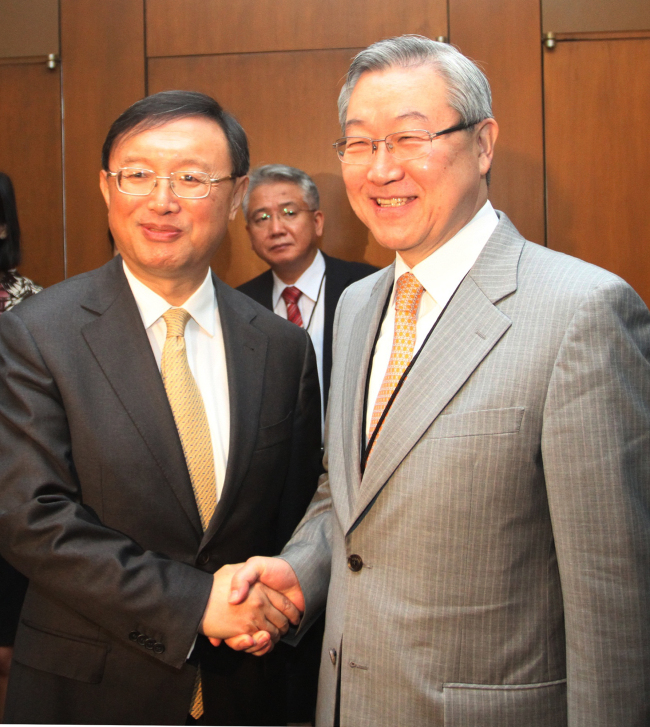Korea to watch China’s drone use for territory claims
By Shin Hyon-heePublished : Sept. 25, 2012 - 20:50
Lee calls top security meeting to discuss N.K., regional tension
Territorial tension is brewing again between Korea and China after Beijing reportedly devised a plan to mobilize drones to monitor areas outside its jurisdiction, including Korea’s island of Ieodo.
Ieodo, or Socotra Rock, has often been a source of diplomatic spats in recent years as it lies in the overlapping section of the exclusive economic zones of Korea and China.
“We’re currently verifying the news reports. While the U.N. Convention of the Law of the Sea ensures the freedom of navigation and fly overs, confirmation of the purpose of the flight should precede them,” Foreign Ministry Spokesman Cho Tai-young told a regular press briefing.
“The government will make its utmost efforts in the operation of the Ieodo Ocean Research Station. It will vigorously respond if there is a problem exercising jurisdiction over Ieodo.”
President Lee Myung-bak will convene a top security meeting Wednesday to discuss North Korea and other pending issues, presidential spokesman Park Jeong-ha said. The session will be attended by the unification and defense ministers, the first vice foreign minister, the head of the National Intelligence Service and the senior presidential security advisor.
Territorial tension is brewing again between Korea and China after Beijing reportedly devised a plan to mobilize drones to monitor areas outside its jurisdiction, including Korea’s island of Ieodo.
Ieodo, or Socotra Rock, has often been a source of diplomatic spats in recent years as it lies in the overlapping section of the exclusive economic zones of Korea and China.
“We’re currently verifying the news reports. While the U.N. Convention of the Law of the Sea ensures the freedom of navigation and fly overs, confirmation of the purpose of the flight should precede them,” Foreign Ministry Spokesman Cho Tai-young told a regular press briefing.
“The government will make its utmost efforts in the operation of the Ieodo Ocean Research Station. It will vigorously respond if there is a problem exercising jurisdiction over Ieodo.”
President Lee Myung-bak will convene a top security meeting Wednesday to discuss North Korea and other pending issues, presidential spokesman Park Jeong-ha said. The session will be attended by the unification and defense ministers, the first vice foreign minister, the head of the National Intelligence Service and the senior presidential security advisor.

China plans to use drones to carry out marine surveillance and boost the country’s presence by 2015, primarily over disputed islands in the East China Sea, called Senkaku in Japan and Diaoyu in China, and the Scarborough Shoal or Huangyan Island claimed by both the Philippines and Beijing.
The submerged rock, located south of Jeju Island and 4.6 meters below sea level, is the foundation for the Ocean Research Station, which was launched in 2003 by the Korean government to study ocean currents and collect data for weather forecasts, and fishery and environmental conservation.
China’s State Oceanic Administration said it completed a pilot program on Sunday in which it deployed the unmanned aerial vehicles in Lianyungang, a coastal city in eastern Jiangsu Province.
The agency plans to establish regulations for full-fledged operation and monitoring bases along the country’s coastline by 2015, China’s official Xinhua News Agency said, citing Yu Qingsong, chief of a related division.
In March, the ministry summoned Beijing’s ambassador to Korea, Zhang Xinsen, to lodge a complaint after Liu Cigui, the director of the SOA, renewed assertion over Ieodo and said his agency would patrol the area with ships and aircraft.
In July 2011, China sent three patrol boats to the waters near Ieodo where Korean workers were trying to pull out a sunken bulk carrier, urging them not to operate in what it claims as its EEZ.
Tension escalated again in December after Beijing announced plans to mobilize a 3,000-ton monitoring ship to the area.
The drone program comes at the height of a territorial dispute between Beijing and Tokyo. The Japanese government’s purchase of the Senkaku early this month from private owners triggered sometimes violent public protests across China. Japanese companies
in China such as Toyota, Honda and Nissan are being threatened with boycotts and scaling back output.
With signs of fallout amplifying, Tokyo dispatched Chikao Kawai, vice foreign minister, to Beijing for talks with his counterpart, Zhang Zhijun, Tuesday.
In New York, Korean Foreign Minister Kim Sung-hwan agreed with his Chinese counterpart, Yang Jiechi, to speed up talks to draw a borderline between the two countries’ EEZs as they held a bilateral meeting on Monday on the sidelines of the 67th session of the United Nations General Assembly.
Japan’s claim over the Korean easternmost islets of Dokdo has also been a constant thorn in bilateral relations.
By Shin Hyon-hee (heeshin@heraldcorp.com)









![[Kim Seong-kon] Democracy and the future of South Korea](http://res.heraldm.com/phpwas/restmb_idxmake.php?idx=644&simg=/content/image/2024/04/16/20240416050802_0.jpg&u=)







![[KH Explains] Hyundai's full hybrid edge to pay off amid slow transition to pure EVs](http://res.heraldm.com/phpwas/restmb_idxmake.php?idx=652&simg=/content/image/2024/04/18/20240418050645_0.jpg&u=20240418181020)

![[Today’s K-pop] Zico drops snippet of collaboration with Jennie](http://res.heraldm.com/phpwas/restmb_idxmake.php?idx=642&simg=/content/image/2024/04/18/20240418050702_0.jpg&u=)